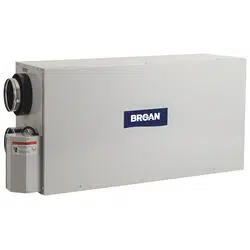Loading ...
Loading ...
Loading ...

VP0009
7. B ALANCING THE UNIT
17
7.1 WHAT YOU NEED TO BALANCE THE UNIT
• A magnehelic gauge capable of measuring 0 to 0.5 inch of water (0 to 125 Pa) and 2 plastic
tubes.
• The balancing chart located on the unit door.
7.2 PRELIMINARY STAGES TO BALANCE THE UNIT
• Seal all the unit ductwork with tape. Close all windows and doors.
• Turn off all exhaust devices such as range hood, dryer and bathroom fans.
• Make sure the balancing dampers are fully open.
NOTE: The balancing dampers are NOT INCLUDED; to be supplied by others. Install the balancing dampers in Fresh air to
building duct and exhaust air from building duct (A and B on illustration below), at the more convenient place.
• Make sure all filters are clean (if it is not the first time you balance the unit).
7.3 BALANCING PROCEDURE
1. Set the unit to high speed.
Make sure that the furnace/air handler blower is ON if the installation is in any way connected to the ductwork of the cold air
return. If not, leave furnace/air handler blower OFF. If the outdoor temperature is below 32°F, make sure the unit is not running in
defrost while balancing. (By waiting 10 minutes after plugging the unit in, you are assured that the unit is not in a defrost cycle.)
2. Place the magnehelic gauge on a level surface and adjust it to zero.
3. Connect tubing from gauge to exhaust air flow pressure taps
(see illustration at right).
Be sure to connect the tubes to their appropriate high/low
fittings. If the gauge drops below zero, reverse the tubing
connections.
NOTE: It is suggested to start with the exhaust air flow
reading because the exhaust has typically more
restriction than the fresh air, especially in cases of
fully ducted installations or source point ventilation.
Place the magnehelic gauge upright and level.
Record equivalent air flow of the reading according
to the balancing chart.
4. Move tubing to fresh air flow pressure taps (see diagram).
Adjust the fresh air balancing damper (A) until the fresh air
flow is approximately the same as the exhaust air flow. If
fresh air flow is less than exhaust air flow, then go back and adjust the exhaust balancing damper (B) to equal the fresh air flow.
5. Secure both dampers in place with a fastening screw.
6. Write the required air flow information on a label and affix it near the unit for future reference (date, maximum speed air flows,
your name, phone number and business address).
NOTE: The unit is considered balanced even if there is a difference of ±10 cfm (or ± 5 l/s) between the two air flows.
VP0024
AB
EXHAUST
AIR FLOW
FRESH
AIR FLOW
Loading ...
Loading ...
Loading ...
